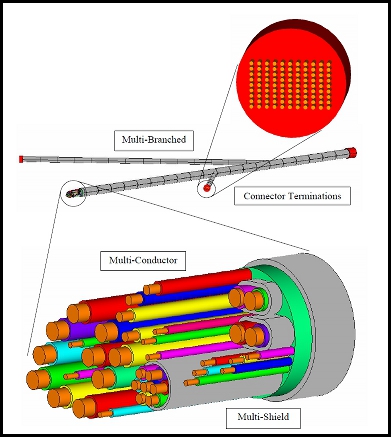MHARNESS to Complete the Last Mile of EM Coupling Simulation
Traditionally, electromagnetic effects simulation has focused on the transients induced on the overall cable bundle of complex systems. MHARNESS is a transmission line solver that reveals the EM transients on the most critical element of systems: the pin interface to electronics systems.
Traditionally, electromagnetic effects simulation has focused on the transients induced on the overall cable bundle of complex systems. MHARNESS is a transmission line solver that reveals the EM transients on the most critical element of systems: the pin interface to electronics systems.
MHARNESS: Multiple Branches, Multiple Conductors, and Multiple Shields
MHARNESS models can contain multiple conductors, multiple shields, and multiple branches to capture the actual cable routing of real buildings, vehicles, aircraft and spacecraft. Each branch segment can contain multiple layers of shields, wires and conductors—all immersed in a variety of respective media. Within MHARNESS are algorithms to analyze electromagnetic coupling through various cable shields to the conductors and wires within. Cable connectors, often possessing different impedance characteristics then the cable itself, are easily defined and employed. A variety of methods are available to terminate each conductor, wire, and shield within a cable harness including circuit terminations. Many types of sources are available to drive the cable system including pin voltages, electric fields, current sources, and plane wave sources.
MHARNESS models can contain multiple conductors, multiple shields, and multiple branches to capture the actual cable routing of real buildings, vehicles, aircraft and spacecraft. Each branch segment can contain multiple layers of shields, wires and conductors—all immersed in a variety of respective media. Within MHARNESS are algorithms to analyze electromagnetic coupling through various cable shields to the conductors and wires within. Cable connectors, often possessing different impedance characteristics then the cable itself, are easily defined and employed. A variety of methods are available to terminate each conductor, wire, and shield within a cable harness including circuit terminations. Many types of sources are available to drive the cable system including pin voltages, electric fields, current sources, and plane wave sources.

Click here for current release information including system requirements.
